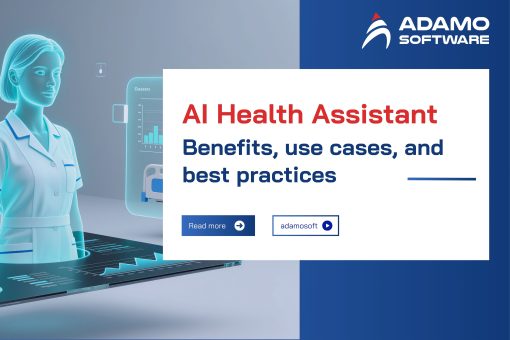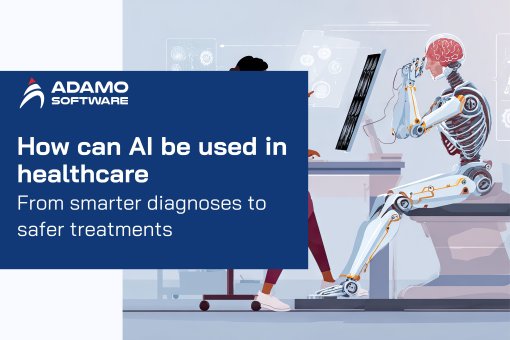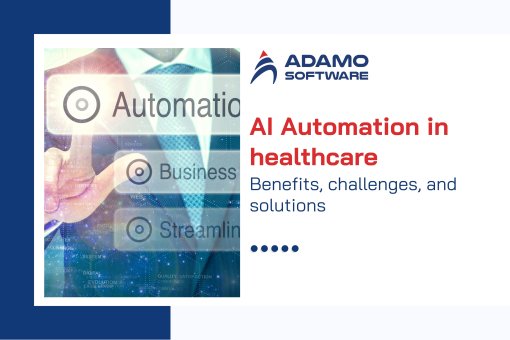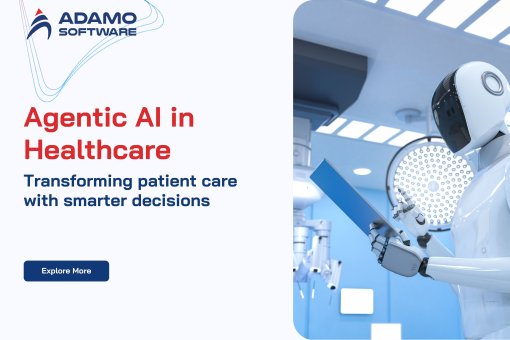Pharma Software Solution: Benefits, features & tech stack Guide
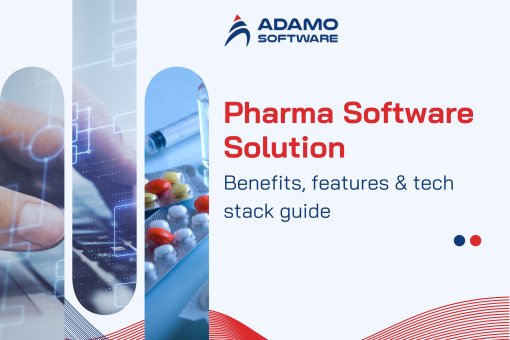
Unlock the potential of your pharma business with a pharma software solution that balances innovation, security, and operational needs.
Today, pharmaceutical firms encounter extra complexity because they must comply with tough rules and hasten the delivery of drugs to patients. Addressing these problems needs a new approach – this means using sophisticated software that combines innovative technology and knowledge of the pharmaceutical field. An effective pharma software solution improves the efficiency of processes and keeps the company compliant. It also improves data organization and reduces the time needed to introduce new treatments.
Success in creating a great pharma software solution depends on correctly choosing the technology tools used. Choosing the right programming languages, frameworks, and cloud services can help your system keep pace and remain secure to meet industry expectations. Grasping the advantages, potential issues, and main characteristics of these systems will help you choose the best solutions. As a result, you’ll be able to keep innovation and smooth operations going.
This article will explore how the selective use of pharma software solutions eases the challenges that complexity presents. We’ll examine the top advantages of these systems, common difficulties that arise during their development, and the features worth considering. We’ll also provide you with helpful tips on choosing the best tech stack. No matter if you’re an executive, working in IT, or developing software, you’ll find helpful information in this guide.
I. Business Benefits of Pharma Software Solution
Using pharma software solutions in the pharmaceutical industry brings many powerful benefits and transformations. We’ll now go into greater detail about these main benefits, explaining how pharma software solutions make a difference.
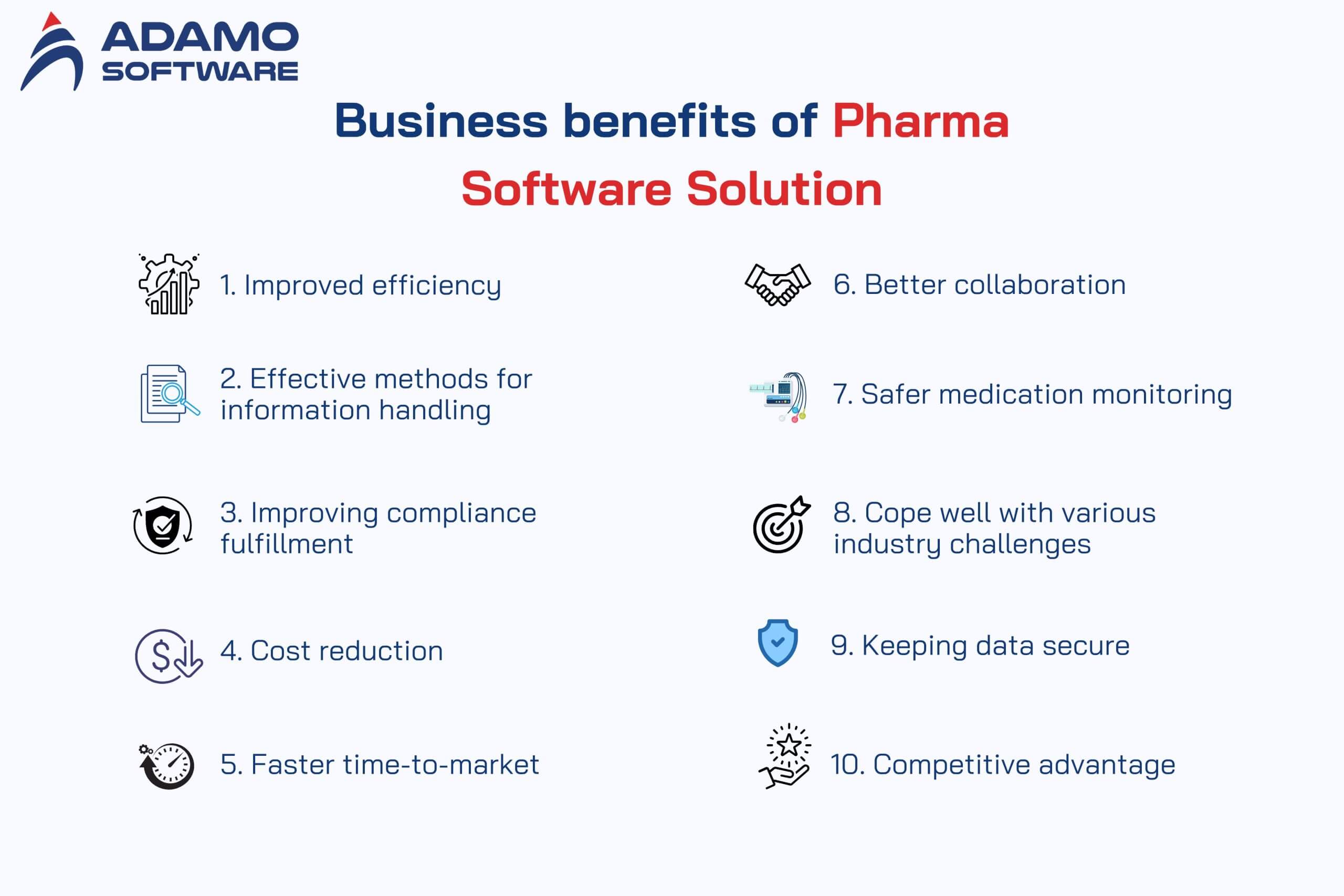
1. Improved efficiency
With pharma software, important functions like developing drugs, managing clinical trials, and following rules are simplified by handling routine and repetitive work automatically. Improvements in order fulfillment automation take the strain off team members, reduce errors, and help complete projects more quickly and successfully. After workflows are streamlined, businesses will be able to make better use of resources and focus more on new developments.
2. Effective methods for information handling
Pharma software solutions enable people to collect, arrange, and review vast amounts of drug data in one place. Processing information accurately and in real time improves medication development decisions, beginning with planning and leading to the product’s reveal to the public. Good pharma software solutions maintain the quality of data and help researchers and regulatory staff access it reliably.
3. Improving compliance fulfillment
Pharma software solutions are developed to assist companies in strictly meeting rules and requirements from the industry and authorities. These systems rely on ensuring that tasks and documents are automated to prevent major penalties and issues. Sticking to the rules not only keeps a company’s reputation untarnished but also creates trust with those it does business with and regulators.
4. Cost reduction
Using automation and improved processes, pharma software solutions let companies slash the costs linked to manual tasks, documents, and resolving mistakes. Managing their product stock well and preventing waste means they can save money when running their business. On top of that, having strong quality control measures keeps companies from facing violations and lowers the number of recalls, saving them money.
5. Faster time-to-market
Pharma software solutions support a more efficient drug journey and better teamwork within the company. With better data handling, stronger communication, and automation, companies can get new medicines to market more rapidly than other businesses.
6. Better collaboration
Pharma software solutions help all employees in a company to share and exchange information quickly. By using enhanced collaboration tools, pharma software solutions help organize projects by having everyone use updated information, avoid confusion, and improve teamwork.
7. Safer medication monitoring
Thanks to pharma software, safety concerns involving medications can be seen and acted on right away. Data collection and alert systems allow you to keep drugs safe and notice any side effects after their official release. This is beneficial for everyone’s health and goodwill toward pharmaceuticals.
8. Cope well with various industry challenges
The development of new rules, evolving markets, and technology causes the drug industry to change. Because these systems are flexible and scalable, companies can speedily update their operations, remain in compliance, and secure their resilience over the years.
9. Keeping data secure
Pharmaceutical companies focus on keeping patient information private. The security within this software includes measures to prevent private data from being seen by unauthorized people and to follow all necessary privacy regulations. Securely managing data makes stakeholders believe in your company more and greatly decreases the threat of a breach.
10. Competitive advantage
With custom pharma software solutions, companies can respond to new trends, thrive in a rapidly changing market, and control their operations efficiently. As a result, they can perform tasks more efficiently, generate interesting answers, and hold firm in the market.
Overall, pharma software solutions are fundamental for any modern pharmaceutical business. Not only do they improve efficiency, manage data, ensure compliance, and cut costs, but they also speed up operations and improve teamwork.
II. Challenges of Pharma Software Solution Development
The creation and implementation of useful pharma software solutions are influenced by a number of significant obstacles. For more details, the list below shows how difficult it can be to develop strong pharmaceutical software solutions:
1. Regulatory compliance
It is a top challenge to guarantee that pharma software solutions stay in line with the strict and always-changing rules and guidelines. Any solution needs to follow the rules set by GMP, GCP, and U.S. FDA regulations. Failing to obey the rules can bring serious penalties, cause legal problems, and ruin a company’s good reputation. To ensure compliance and assist during regulatory audits, pharma software developers must include end-to-end validation, a history of events, and quality management systems.
2. Data security and privacy
Since pharma software solutions deal with important patient and company data, it is important to ensure strong security of all data. Because cyber threats keep changing, data protection needs to involve encryption, tough access policies, and following the regulations HIPAA and GDPR. If data is not properly protected, the integrity of the medical firm can be compromised. This may put both patients at risk and harm the company’s reputation, with legal consequences.
3. Integration complexity
A lot of pharmaceutical companies rely on several old systems and different technologies in their departments. To work well, the new pharma software must be integrated with the existing systems. But, this is generally both hard to do and requires time. Smooth integration is needed to keep data traveling well, merge data from different stores, and maintain operations in a consistent manner.
4. Resource restrictions
Pharma software has to be developed by specialized pharmaceutical software developers, with expensive infrastructure, and should be consistently updated for upkeep. Lacking resources and budgets can slow down projects or prevent firms from offering all the functions they wish to add. A main difficulty in the pharma industry is finding a balance between cost savings and excellent software development.
5. Data standardization
Different parts of the pharmaceutical industry, like clinical trials, manufacturing, and supply, create large collections of data. All pharma software solutions need to standardize this mixed data for better consistency, accuracy, and usability. Storing data in a standard way and at the same quality is not easy across different systems. But this is crucial for reliable analysis and compliance reporting.
6. Globalization challenges
Medical drug companies run their operations in other countries, dealing with a range of laws, languages, and customs. The software must be able to adapt to different international regulations to work across the world for the pharmaceutical industry. As a result, mobile apps must be easily designed and adapted to fit various markets and obey international standards.
In short, creating effective solutions for the pharma sector requires dealing with difficult regulatory, security, integration, financial, data, and globalization issues. Solving these matters with professionals and modern tools is crucial to making software that matches the pharmaceutical industry’s high standards.
Read more: Pharma Software types explained: How to find the ideal solution
III. Must-have features of Pharma Software Solution
Features in pharma software solutions are developed to react to the particular requirements present in the pharmaceutical field. These methods help to improve operational work and guarantee compliance, safety, and excellent quality throughout drug development and manufacturing. Below, we list out seven important features that are common in a pharma software solution:
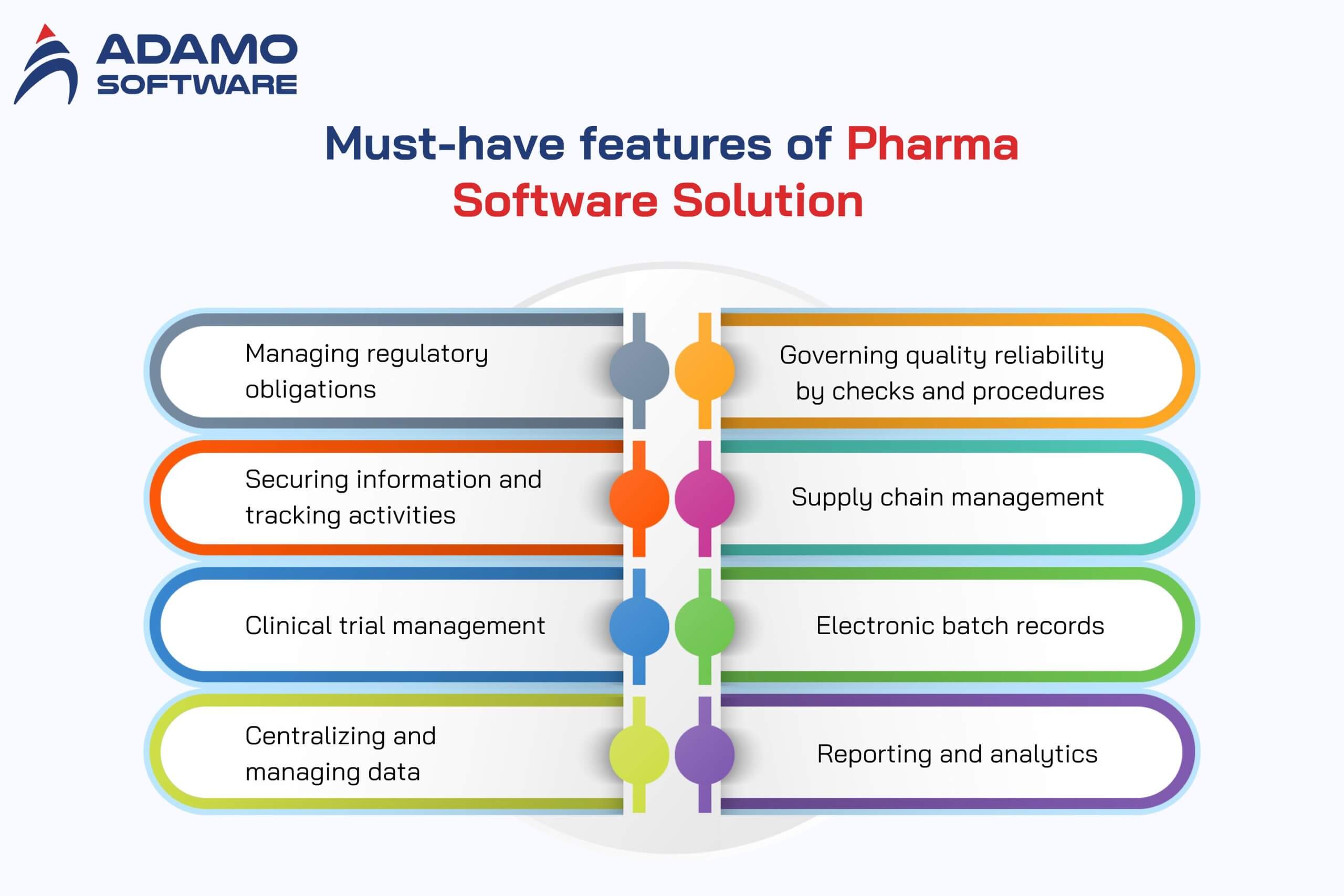
1. Managing regulatory obligations
A pharma software solution has comprehensive tools to support the following regulations and standards, such as GMP and GCP. As a result, pharmaceutical companies have access to organized compliance info, keep track of any new laws, and are ready for inspections. Automating compliance procedures eliminates risks and enables the business to interact well with local authorities.
2. Securing information and tracking activities
Keeping patient data and private info safe is the number one priority in pharma software systems. They apply substantial security features, including encryption, access that depends on one’s position, and reliable authentication procedures. They also make sure to keep complete records that track all usage by users inside the system. With this, you are responsible, can protect your intellectual work, and quickly notice any data security issues.
3. Clinical trial management
Special software in pharma helps streamline the whole clinical trial process. This is possible through patient enrollment, organizing schedules, collecting information, and preparing reports for regulations. As a result, the trial’s real-time performance can be monitored, and the data remains correct and reliable. The software frees clinical teams from clerical duties, speeds up the trial process, and better organizes work steps among teams.
4. Centralizing and managing data
An important element of pharma software is its ability to handle, store, and analyze large amounts of data from drug development. It gives centralized storage for data that can easily integrate information from several sources. Better access to data helps those involved with decisions make choices that are correct and current.
5. Governing quality reliability by checks and procedures
The production and distribution of drugs should always maintain excellent standards. Pharma software includes quality control parts that closely oversee procedures, detect any deviation, and make sure everything follows the required rules. It serves to avoid defects, lower risks of product retakes, and support improvements through good quality metrics insights.
6. Supply chain management
Good management of the drug supply chain helps ensure both availability and the ability to trace all products. Pharma software handles every step of the supply chain, including managing stock, procurement, and distribution. Because they improve how the supply chain communicates and is seen, these innovations decrease mistakes, speed up progress, and deliver medications as planned.
7. Electronic batch records
With pharma software, records are now handled electronically and automatically through a process called electronic batch records. As a result, your records are accurate and always up to date, because this structure avoids the inefficient and error-prone parts of using paper. EBR improves how the plant runs and keeps your business within regulations. It also allows you to easily access information about your production for audits and quality checks.
8. Reporting and analytics
Pharma software solutions rely on advanced reporting tools to give a full picture of key performance, compliance, and how the company operates. They help organizations make informed decisions by identifying noticeable trends, discovering challenges, and bringing new opportunities to light. Plus, users can build their own dashboards and generate reports automatically, making everything clearer and easier to plan.
All in all, a well-built pharma software connects key features to meet regulations, secure data, and handle clinical trials with greater effectiveness. It ensures accurate supply chains, improves manufacturing precision, and offers deep analytics to boost operational efficiency and competitiveness.
IV. Choosing the right tech stack for Pharmaceutical Software development
Choosing the right set of programming languages, frameworks, and databases is key to building a functional pharmaceutical software product. Collaborating with people skilled in developing products for pharmaceutical firms results in safe, adjustable, and industry-specific software.
Those providing development should merge advanced knowledge of health data with an effective range of technology tools. Many pharmaceutical companies use Python for reliable, scalable backend development in their software. As for designing user-friendly interfaces for the front end, they would generally use React. By combining different options, they can deliver a smooth user experience that is appreciated by various people across pharmaceutical firms.
1. Using Python for the backend
It is widely believed that Python makes an excellent backend choice for pharma software because it can manage complex data well. Because of its easy-to-understand rules and many libraries, developers can build trusted, expanding, and sustainable applications. Because there is a strong Python community support and resources, learning and innovating happen even faster.
Pharma software needs robust tracking and monitoring for clinical trials, drug development, and ensuring compliance with regulations. Because Python can quickly process large sets of data and give real-time answers, it is useful for these crucial functions. Hiring a Python developer outside of the company allows pharmaceuticals to use safe and effective solutions that improve their backups.
2. Using React for the user interface
Quickly developing user interfaces in pharma software solutions is possible with React because it is both flexible and cost-effective. Because it works with Windows, macOS, and Linux, many more users can benefit from the software. React’s modular architecture makes UI updates simple, keeping the system fast and ensuring user satisfaction.
Thanks to React, the application’s navigation and interaction become simpler as components can be reused and updated effortlessly. As a result, the user experience improves, which is vital since pharmaceutical professionals have many different requirements. Because of its flexibility, it helps create web applications as well as hybrid ones, which pharma companies can adapt to fulfill their own needs.
3. AWS for Cloud Solutions
AWS helps the pharmaceutical industry meet HIPAA and GDPR standards with full compliance across 1,000+ regulations. It helps pharma companies accelerate launches, ensure operational resilience, and foster innovation with scalable solutions.
With support for AI and IoT on AWS, pharmaceutical organizations can include these advanced abilities in the software they develop. Because its structure can change, healthcare software for businesses can stay effective and provide high-quality results even as their workloads and user count grow. AWS’s certifications also ensure that pharmaceutical companies can follow regulations easily.
Basically, selecting the best technology tools is essential to any successful pharma software project. With Python, React, and AWS, pharmaceutical companies can grow, stay compliant, and adapt to evolving demands. Relying on tech experts ensures pharma software is built effectively to maximize value.
V. Implement pharma software solution with Adamo Software
At Adamo Software, our solutions are built to suit the special needs of the pharmaceutical industry. Based in Vietnam, our team leverages healthcare expertise, AI, blockchain, and cloud tech to deliver secure, scalable, and compliant software.

We use the agile method with transparent progress, helping ensure that your company can innovate and succeed. Adamo is the company to call for your needs in clinical trial management, keeping data secure, or managing your supply chain.
Ready to develop your healthcare software? Get in touch with us today!







